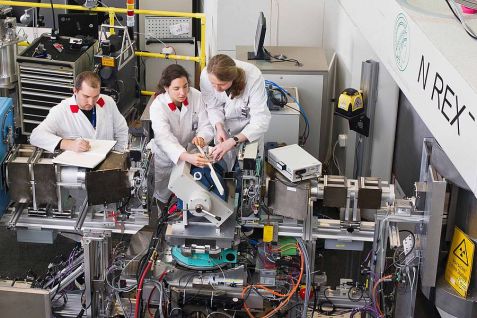MLZ is a cooperation between:
 > Technische Universität München
> Technische Universität München > Helmholtz-Zentrum Hereon
> Helmholtz-Zentrum Hereon
 > Forschungszentrum Jülich
> Forschungszentrum Jülich
MLZ is a member of:
 > LENS
> LENS > ERF-AISBL
> ERF-AISBL
MLZ on social media:

MLZ (eng)
Lichtenbergstr.1
85748 Garching
22.10.2012
Magnetic neighbour manipulates superconductor
Using neutrons, researchers observed new effects between magnetic and superconducting materials.

The magnetic effects between the high-temperature superconductor and the manganate were analyzed by neutron spectroscopy, among others at the instrument NREX at the Research Neutron Source Heinz Maier-Leibnitz (FRM II) in Garching.
High-temperature superconductors fascinate and frustrate researchers since their discovery more than 25 years ago. As it is well understood why some metals suddenly transport current with zero electrical resistance at temperatures close to absolute zero, researchers have not yet readily explained, why at significantly higher temperatures certain copper oxide ceramics are also superconductive. Physicists now believe, however, that the high-temperature superconductivity develops as a result of magnetic interactions.
Due to their amazing magnetic properties, so called magnetic oxides are also in the focus of many researchers. A few years ago, scientists discovered in thin films of manganates – the most famous group of magnetic oxides – an effect called colossal magnetoresistance (CMR): When applying an external magnetic field, the electrical resistance decreases significantly in this material. Furthermore, at a certain temperature the electrical conductivity in a manganate changes from an insulator to an electrical conductor. At the same time, the magnetic properties of the material alter from paramagnetism to ferromagnetism.
In order to investigate effects between the two substances, a team of scientists led by Christian Bernhard of the University of Fribourg stacked both substances to a superlattice with a thickness of a few nanometers. In fact, the physicists were able to observe an unexpected magnetic proximity effect between the two materials: It was found that the ferromagnetism in the manganite was suppressed significantly, whereas the copper oxide ceramic showed a spontaneous magnetization with the magnetic moments reversely aligned to that of the manganate. Further experiments also suggested that the strength of the magnetic proximity effect can easily be tuned by changing the electronic properties of the manganate. The magnetic properties of the superlattice were analyzed by neutron spectroscopy, among others at the instrument NREX at the Research Neutron Source Heinz Maier-Leibnitz (FRM II) in Garching.
From their experiments, the researchers hope to gain a better understanding of the fundamentals of high-temperature superconductivity. On the other hand, they expect to make progress in the field of spintronics. This new field of research at the boundary between magnetism and electronics aims to manipulate the spin of electrons by electric or magnetic fields so that it can one day be used for electronic data processing.
Original publication:
D. K. Satapathy, M. A. Uribe-Laverde, I. Marozau, V. K. Malik, S. Das, Th. Wagner, C. Marcelot, J. Stahn, S. Brück, A. Rühm et al.
Magnetic Proximity Effect in YBa2Cu3O7/La2/3Ca1/3MnO3 and YBa2Cu3O7/LaMnO3+δ Superlattices
Physical Review Letters,
108(19):197201
DOI: 10.1103/PhysRevLett.108.197201
Further information
Research group Prof. Christian Bernhard,
University of Fribourg
Contact
Dr. Yury Khaydukov,
instrument scientist NREX,
Research Neutron Source Heinz Maier-Leibnitz (FRM II),
Tel. +49 89 289 14769,
E-Mail: yury.khaydukov@frm2.tum.de
Press contact
Petra Riedel,
press officer,
Research Neutron Source Heinz Maier-Leibnitz (FRM II),
Tel. +49 89 289 12141,
E-Mail: presse@frm2.tum.de
MLZ is a cooperation between:
 > Technische Universität München
> Technische Universität München > Helmholtz-Zentrum Hereon
> Helmholtz-Zentrum Hereon
 > Forschungszentrum Jülich
> Forschungszentrum Jülich
MLZ is a member of:
 > LENS
> LENS > ERF-AISBL
> ERF-AISBL
MLZ on social media:


